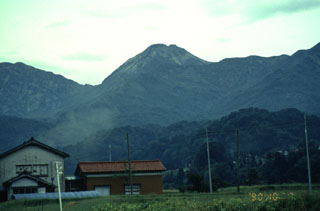Report on Niigata-Yakeyama (Japan) — April 1983
Scientific Event Alert Network Bulletin, vol. 8, no. 4 (April 1983)
Managing Editor: Lindsay McClelland.
Niigata-Yakeyama (Japan) Fresh ash on snow
Please cite this report as:
Global Volcanism Program, 1983. Report on Niigata-Yakeyama (Japan) (McClelland, L., ed.). Scientific Event Alert Network Bulletin, 8:4. Smithsonian Institution. https://doi.org/10.5479/si.GVP.SEAN198304-283090
Niigata-Yakeyama
Japan
36.921°N, 138.036°E; summit elev. 2400 m
All times are local (unless otherwise noted)
On the morning of 15 April, a local resident noticed gray-tinted snow on the N flank and a plume near the summit area. On 18 April, a joint observation team from the firehouse, the district forestry office, and the city office of [Itoigawa] (20 km NE of the volcano), visited the summit area and found that ash had fallen on the snow over the N flank. Analysis of an ash sample at Niigata University showed that the ash was not freshly magmatic, but was composed of fragmented old rock that contained mainly plagioclase, amphibole, and pyroxene phenocrysts. No seismic activity was recorded, but no JMA seismograph is installed within 30 km of the volcano.
The volcano is a 400-m-high lava dome that rests on 2,000-m-high mountains underlain by sedimentary rock. During its last eruption, a phreatic explosion from fissures in the N and W flanks [near the summit] on 28 July 1974, three climbers were killed by ejecta, ash fell as far as 100 km to the NE damaging about 220 km2 of farmland, and two mudflows descended the N flank.
Geological Summary. Niigata-Yakeyama, one of several Japanese volcanoes named Yakeyama ("Burning Mountain"), is an andesitic-to-dacitic lava dome in Niigata prefecture in west-central Honshu, about 20 km from the coast. The volcano was constructed on a base of Tertiary mountains beginning about 3,100 years ago. Three major eruptions in the past 1,000 years have produced pyroclastic flows and lava flows that traveled mainly down the Hayakawa river valley to the N and NW. The first of these eruptions, in 887 CE (and possibly 989 CE), produced the Hayakawa pyroclastic flow, which reached the coast, and the massive Mae-yama lava flow, which traveled about 6.5 km down the Hayakawa river valley. The summit lava dome was emplaced during the 1361 CE eruption, and the last magmatic eruption took place in 1773 CE. Eruptive activity since 1773 has consisted of relatively minor phreatic explosions from several radial fissures and explosion craters that cut the summit and flanks of the dome.
Information Contacts: JMA, Tokyo.

